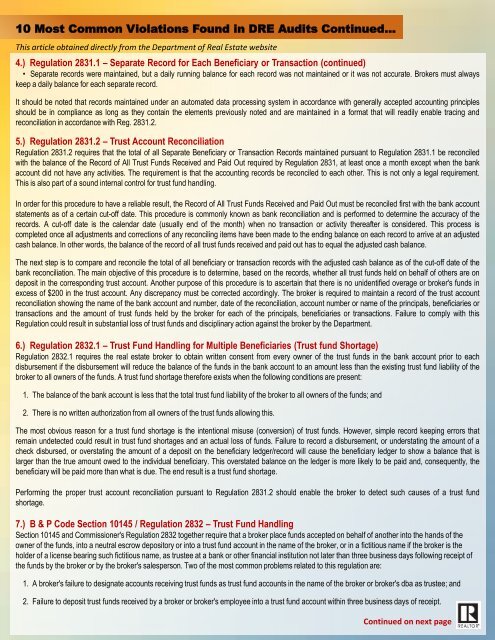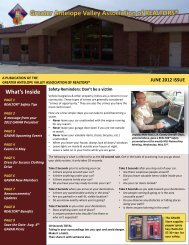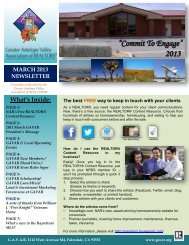May 2013 - Greater Antelope Valley Association of REALTORS
May 2013 - Greater Antelope Valley Association of REALTORS
May 2013 - Greater Antelope Valley Association of REALTORS
- No tags were found...
Create successful ePaper yourself
Turn your PDF publications into a flip-book with our unique Google optimized e-Paper software.
10 Most Common Violations Found in DRE Audits Continued…This article obtained directly from the Department <strong>of</strong> Real Estate website4.) Regulation 2831.1 – Separate Record for Each Beneficiary or Transaction (continued)• Separate records were maintained, but a daily running balance for each record was not maintained or it was not accurate. Brokers must alwayskeep a daily balance for each separate record.It should be noted that records maintained under an automated data processing system in accordance with generally accepted accounting principlesshould be in compliance as long as they contain the elements previously noted and are maintained in a format that will readily enable tracing andreconciliation in accordance with Reg. 2831.2.5.) Regulation 2831.2 – Trust Account ReconciliationRegulation 2831.2 requires that the total <strong>of</strong> all Separate Beneficiary or Transaction Records maintained pursuant to Regulation 2831.1 be reconciledwith the balance <strong>of</strong> the Record <strong>of</strong> All Trust Funds Received and Paid Out required by Regulation 2831, at least once a month except when the bankaccount did not have any activities. The requirement is that the accounting records be reconciled to each other. This is not only a legal requirement.This is also part <strong>of</strong> a sound internal control for trust fund handling.In order for this procedure to have a reliable result, the Record <strong>of</strong> All Trust Funds Received and Paid Out must be reconciled first with the bank accountstatements as <strong>of</strong> a certain cut-<strong>of</strong>f date. This procedure is commonly known as bank reconciliation and is performed to determine the accuracy <strong>of</strong> therecords. A cut-<strong>of</strong>f date is the calendar date (usually end <strong>of</strong> the month) when no transaction or activity thereafter is considered. This process iscompleted once all adjustments and corrections <strong>of</strong> any reconciling items have been made to the ending balance on each record to arrive at an adjustedcash balance. In other words, the balance <strong>of</strong> the record <strong>of</strong> all trust funds received and paid out has to equal the adjusted cash balance.The next step is to compare and reconcile the total <strong>of</strong> all beneficiary or transaction records with the adjusted cash balance as <strong>of</strong> the cut-<strong>of</strong>f date <strong>of</strong> thebank reconciliation. The main objective <strong>of</strong> this procedure is to determine, based on the records, whether all trust funds held on behalf <strong>of</strong> others are ondeposit in the corresponding trust account. Another purpose <strong>of</strong> this procedure is to ascertain that there is no unidentified overage or broker's funds inexcess <strong>of</strong> $200 in the trust account. Any discrepancy must be corrected accordingly. The broker is required to maintain a record <strong>of</strong> the trust accountreconciliation showing the name <strong>of</strong> the bank account and number, date <strong>of</strong> the reconciliation, account number or name <strong>of</strong> the principals, beneficiaries ortransactions and the amount <strong>of</strong> trust funds held by the broker for each <strong>of</strong> the principals, beneficiaries or transactions. Failure to comply with thisRegulation could result in substantial loss <strong>of</strong> trust funds and disciplinary action against the broker by the Department.6.) Regulation 2832.1 – Trust Fund Handling for Multiple Beneficiaries (Trust fund Shortage)Regulation 2832.1 requires the real estate broker to obtain written consent from every owner <strong>of</strong> the trust funds in the bank account prior to eachdisbursement if the disbursement will reduce the balance <strong>of</strong> the funds in the bank account to an amount less than the existing trust fund liability <strong>of</strong> thebroker to all owners <strong>of</strong> the funds. A trust fund shortage therefore exists when the following conditions are present:1. The balance <strong>of</strong> the bank account is less that the total trust fund liability <strong>of</strong> the broker to all owners <strong>of</strong> the funds; and2. There is no written authorization from all owners <strong>of</strong> the trust funds allowing this.The most obvious reason for a trust fund shortage is the intentional misuse (conversion) <strong>of</strong> trust funds. However, simple record keeping errors thatremain undetected could result in trust fund shortages and an actual loss <strong>of</strong> funds. Failure to record a disbursement, or understating the amount <strong>of</strong> acheck disbursed, or overstating the amount <strong>of</strong> a deposit on the beneficiary ledger/record will cause the beneficiary ledger to show a balance that islarger than the true amount owed to the individual beneficiary. This overstated balance on the ledger is more likely to be paid and, consequently, thebeneficiary will be paid more than what is due. The end result is a trust fund shortage.Performing the proper trust account reconciliation pursuant to Regulation 2831.2 should enable the broker to detect such causes <strong>of</strong> a trust fundshortage.7.) B & P Code Section 10145 / Regulation 2832 – Trust Fund HandlingSection 10145 and Commissioner's Regulation 2832 together require that a broker place funds accepted on behalf <strong>of</strong> another into the hands <strong>of</strong> theowner <strong>of</strong> the funds, into a neutral escrow depository or into a trust fund account in the name <strong>of</strong> the broker, or in a fictitious name if the broker is theholder <strong>of</strong> a license bearing such fictitious name, as trustee at a bank or other financial institution not later than three business days following receipt <strong>of</strong>the funds by the broker or by the broker's salesperson. Two <strong>of</strong> the most common problems related to this regulation are:1. A broker's failure to designate accounts receiving trust funds as trust fund accounts in the name <strong>of</strong> the broker or broker's dba as trustee; and2. Failure to deposit trust funds received by a broker or broker's employee into a trust fund account within three business days <strong>of</strong> receipt.Continued on next page





